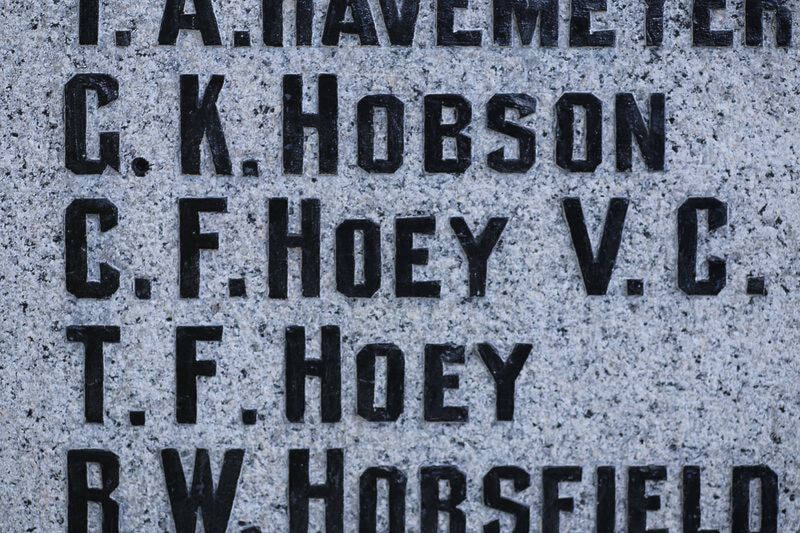By T.W. Paterson
Here in Duncan we have Charles Hoey, VC Park, that grassy and treed strip between the Cowichan Valley Museum (E&N station) and Trunk Road where, appropriately, the Cenotaph is located.
It’s named, of course, in honour of Charles Ferguson Hoey, the Cowichan Valley’s only winner of the British Commonwealth’s highest honour for gallantry, the Victoria Cross, during the Second World War. There’s also a monument to the Burma Campaign in which he served and died beside his favourite childhood fishing hole on the Cowichan River.
More recently, they’ve created a memorial at Sidney in memory of another B.C. Victoria Cross winner, Lieut. Robert Hampton ‘Hammy’ Gray, VC, DSC, RCNVR, who also was awarded his VC posthumously while fighting the Japanese. Charles Hoey was serving with an English regiment, Hammy Gray, a torpedo bomber pilot, served with the Royal Navy Fleet Air Arm.
Most Commonwealth nations have now established their own honours system but the Victoria Cross remains one of the most prestigious awards for heroism of all time. Since 1856, there have been only 1,355 recipients (three having been earned twice by their holders), of whom just 99 are Canadians. Incredibly, three of these heroes came not just from the same city but had lived on the same street!
This year, Canada Post issued a postage stamp honouring the three heroes who inspired the naming of Valour Road.
Originally Pine Street, three-kilometre-long Valour Road in Winnipeg’s West End district was re-christened to honour the three First World War heroes who’d lived at different locations along the road. We can only wonder at the odds of their having been ‘neighbours’ before going to war and proving themselves worthy of King and country’s highest award for heroism.
According to Valour Canada, Sgt. Frederick Hall gave his life in the infamous Second Battle of Ypres to save a wounded companion while serving with the 8th Battalion of the Canadian Expeditionary Force which was affiliated with the 90th Winnipeg Rifles.
As company sergeant-major he and his battalion were ordered to Flanders, Belgium, in 1915. That’s where the Germans launched their first poisonous gas attack.
“On the night of 24 April 1915,” Valour Canada tells us, Hall “overheard his fellow soldier, Private Arthur Clarkson, crying out for help as he lay dying [15] metres from the trench. Though venturing into no-man’s land under heavy enemy gunfire was often deadly, Hall didn’t hesitate to act quickly. That same day he had already run out twice to save two different injured men from certain death and he had been successful both times.
“On his first effort to rescue Clarkson, Hall went with two other men. The attempt failed when both suffered injuries and returned to the trench. Hall, however, refused to give up. He tried again, alone this time, and reached Clarkson, but as he lifted the Private from the ground, Hall was shot in the head. Both men died. Hall was posthumously awarded the Victoria Cross for his selfless and fearless acts. His mother later accepted the award on his behalf.”
Corporal Leo Clarke, VC, a star athlete and a surveyor by trade, was the second of the three heroes of Pine Street. In 1914, he enlisted in Winnipeg’s 27th Battalion, CEF, and in mid-1915 was sent to France. There, he transferred to the 2nd Battalion, CEF, to join his brother, Charlie, as a bomber (hand grenades were known as Mills bombs) and promoted to non-commissioned officer.
In September 1916, while under heavy fire during the Battle of the Somme in France, the 2nd Battalion were ordered to capture and secure enemy trenches to prepare the way for an advance. Clarke’s unit was decimated, killed or wounded; only Clarke was left standing. With just a pistol, having thrown all his grenades, Clarke fought off two enemy officers leading a party of 20 men and, despite suffering a bayonet wound to the knee, killed all but one whom he took prisoner.
For this truly amazing feat, Clarke was promoted to sergeant and was awarded the Victoria Cross. Just weeks later, he was wounded by enemy artillery shells, and on Oct, 19, 1916, he succumbed to his injuries.
Lieut. Robert Shankland, VC, originally of Scotland and a resident of Pine Street since 1911, had been among those who quickly answered their country’s call, joining the 43rd Battalion (Cameron Highlanders of Canada), CEF. Promoted to sergeant-major, he demonstrated his mettle at Sanctuary Wood in Belgium as a stretcher-bearer, removing wounded men while under fire, for which he was awarded the Distinguished Conduct Medal and promoted to lieutenant.
During the infamous Battle of Passchendaele (a.k.a. the Third Battle of Ypres), July-November 1917, the 43rd Battalion was ordered to capture enemy trenches along Bellevue Spur after a previous assault had been all but obliterated by shell fire. To again quote Valour Canada: “Shankland once again took the lead, encouraging his platoon to stand strong against enemy fire even as many of them were injured or killed. After securing a defendable position, Shankland rallied in reinforcements and then continued the advance…”
It was for this attack which forced the Germans to retreat that he received the Victoria Cross.
Only Shankland of the three heroes from Winnipeg’s Pine Street survived the war; in 1925, he attended the ceremony for the renaming of Pine Street to Valour Road. He went on to serve overseas in the Second World War and died in 1968.
(To learn more about Valour Road and the men who hailed from that Winnipeg route, watch Heritage Minutes’ Valour Road (Historica Canada).)
